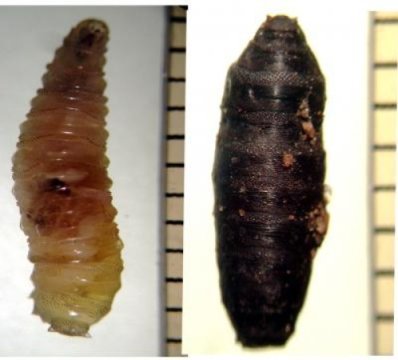The non-biting blowfly Chrysomya megacephala is a common sight on dead bodies and forensic investigators use them to determine the time of death, referred to as the post mortem interval. A report from Tamil Nadu analyzed morphological features and molecular characterization through generation of DNA barcoding of the synanthropic (being ecologically associated with humans) derived form of C. megacephala for the first time. Their findings are significant in forensic sciences and were published in the open access Biodiversity Data Journal.
 This image shows the larva and pupa of Chrysomya megacephala.
This image shows the larva and pupa of Chrysomya megacephala.
Image via sciencedaily
Chrysomya megacephala is a tremendously abundant species and is used as fish bait in northern and south-west India. It is known to breed in human faeces, decomposed meat and fish as well as in discarded organic materials, and thrives on corpses in many parts of the world. This fly therefore serves as a potential vector of many diseases due to its close association with human dwellings and is considered important in medical, veterinary and forensic sciences.
Post mortem interval (PMI) determination is useful in cases of homicide, suicide and accidental or unattended death because of natural causes. An important aspect of calculating the PMI is the accurate and quick identification of the dipteran fly collected from a crime scene.
When determining PMI, behavior and developmental times of the specie is essential. The most common way currently used to identify dipteran flies is to study the adult stage under a compound microscope. This requires that the larvae collected at the scene be reared to maturity. The fly can be identified in its young, larval form but if the critical characteristics are small or vary ever so slightly, misidentification is possible.
However, morphological identification of the fly can be difficult. But identifying them genetically, by encoding collected DNA sequences of mitochondrial cytochrome oxidase gene subunit I (mtCOI), is a much more precise method. Three forms of C. megacephala are recognized presently, those being the normal form (nf), the synanthropic derived form (sdf) and the recently reported feral derived form (fdf).
Nf is confined to forests of South Pacific Islands while the sdf form has spread around the world from Papua New Guinea. Fdf, found in the forests of the Himalaya, India is morphologically intermediate between normal and synanthropic derived forms. However, the occurrence of the synanthropic derived form of C. megacephala has not been documented in the State of Tamil Nadu, India.
In this context, a report for the first time for C. megacephala (sdf) from Royapuram fishing harbour, Chennai, Tamil Nadu, South East India is significant. A colony of C. megacephala was established from numerous second and third instar larvae collected from decaying fishes. The life expectancy of this fly is 40-45 days. Freshly emerged adults from pupae were identified through morphological and molecular studies.



